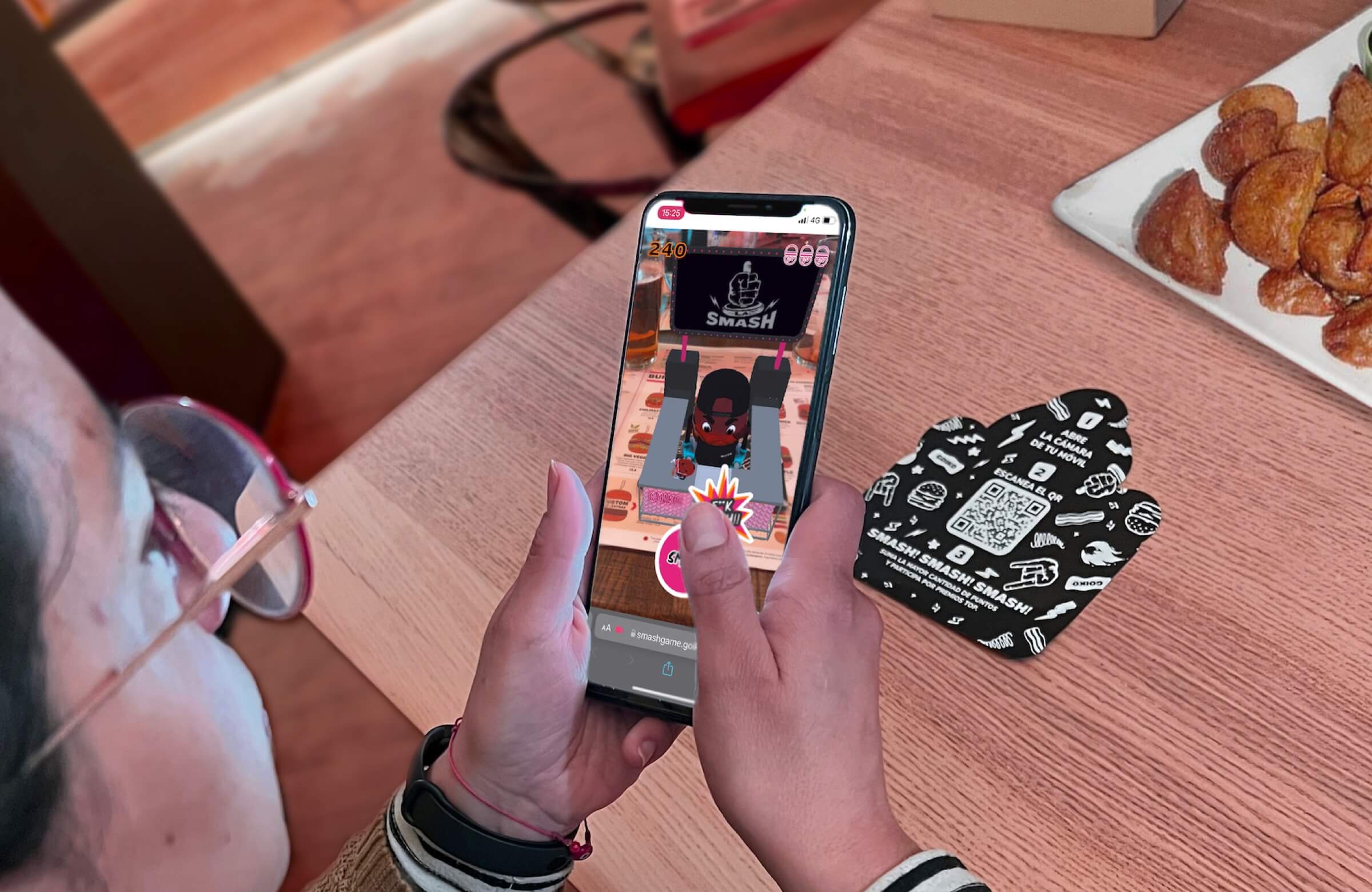AR in marketing: the new digital advertising models
Contents
Augmented Reality has recently become one of the most widely used tools in marketing campaigns. Every day, more and more brands are betting on experiential marketing and, nowadays, AR turns out to be their perfect ally due to the great impact it generates.
For a few years now, it has been said that augmented reality would have an exponential growth, both within many companies and in advertising. Well, it seems that this moment has already arrived because more and more advertisements and digital marketing campaigns are offering web AR experiences. This refers to experiences that the user can see immediately in a web navigator without the need to download an app.
In fact, according to the Snap Consumer AR Global Report 2021, 74% of consumers worldwide expect to make even more use of AR in their everyday lives in the next five years. This effectively translates into a redefinition of brands’ digital strategy as well as user experience.
Goals and KPIs of an augmented reality advertising campaigns
Engaging and making the audience fall in love is an increasingly difficult challenge. Consumer behaviour and trends are changing, as are their needs. Society is oversaturated with information and advertisements, so companies have to find new ways to create new advertising solutions and, more importantly, to deliver what society demands: user experience (UX).
This is exactly what augmented reality offers to potential customers of brands. It therefore brings many benefits both to the audience, who can experience, feel and have fun, and to companies, who see a very positive return on their augmented reality marketing campaigns.
Generate more leads and improve your conversion rate
According to Snap Consumer AR 2021, there are currently more than 100 million consumers shopping through augmented reality experiences. By 2025, it is predicted that nearly 75% of the world’s smartphone-using population will be frequent AR consumers.
Brands can benefit and offer their potential customers personalised and more engaging experiences. As a result, web traffic and the number of leads will increase and, more importantly, the conversion rate will increase by up to 94% more, according to the same report.
These metrics are not the only ones that improve, but also the time a user spends on the website or on the advert and the purchasing decision power is multiplied.
Increases engagement
Experiences, more than any text, image or video advertisement, generate emotions in users that make the interaction between the brand and users last over time and be repeated. Experiential marketing with augmented reality, therefore, offers almost double the visual attention. This translates into stronger memory and more powerful responses from consumers.
So much so that people who frequently use augmented reality are 50% more likely to pay attention to a brand.
Improve Net Promoter Score (NPS)
A good augmented reality advertising campaign will offer the user a unique experience. This is what people are looking for, to experience, to be excited and to live adventures. As a result, in addition to engagement, the NPS will also improve. This is the ultimate goal of a company, not only to build customer loyalty, but also for customers to become brand promoters and to share and recommend it.
If the experience generates what they are looking for, they will want to share it and enjoy it with others. In fact, 54% of Generation-Z consumers, 64% of millennials and 63% of Generation-X say they share an AR experience with family and friends.
Improve brand positioning and build trust
If the experience that users get from a web AR campaign is positive, they will consciously identify with the brand, which will increase its position in relation to competitors and may even become top of mind. Every time that emotion or feeling is activated, the brand will appear first in the consumer’s mind.
In addition, AR experiences give greater confidence in the brand and the quality of its products, according to 56% of shoppers.
Differentiation
Augmented reality provides such a realistic user experience that it creates a much deeper and more consolidated memory than any other type of advertising campaign. This creates a closer relationship between the brand and the user. As a result, it stands out from the rest because it not only shows its product or service, but also shares exactly what it means to buy it.
Furthermore, brands that offer AR experiences are 41% more likely to be considered.
Benefits of augmented reality in marketing and advertising
Augmented Reality and Marketing are two concepts that go hand in hand nowadays. AR has an infinite number of applications, can be implemented in any industry and offers many possibilities in the area of advertising.
We have already mentioned that more and more companies from different sectors are incorporating this technology into their marketing campaigns, but how do they integrate it and what role does AR play?
- It allows for a much more immersive and interactive storytelling format based on three-dimensional experiences. It also has the ability to bring together multiple digital communication assets and branded content.
- It offers additional but significant information. For example, a bottle of wine with a QR code that, when scanned, shows its characteristics and fun facts.
- Add value and originality. Many brands are starting to develop web AR games with incentives and prizes to offer a longer and more fun experience to the user in order to build a relationship.
- It offers a real experience and creates a new bidirectional communication channel that leads to user interaction. For example, a mupi or a billboard on the street or at a bus stop with an integrated augmented reality experience. A new model of interactive advertising with a much more attractive format to seduce the user.
- It creates a relationship between the brand and the user through gamification processes. We are talking, for example, about being able to take the user to different locations, such as a treasure hunt, or even the creation of interactive games. Imagine you are in a restaurant and, while you are waiting for your food, you can play a game, win prizes and even free food. This is what Goiko did for a campaign to launch a new burger. We talk about it in more detail below.
Augmented reality advertising examples
AR experiences have already been implemented in countless industries and sectors. We are talking about education, tourism, hospitality, fashion, wine, the electricity industry, petrol stations, the medical sector and any other area you can imagine.
Moreover, they have the great advantage that they can be created in a totally customised way according to the company, the use and the objective. They can also be displayed in different formats and supports.
Let’s look at some examples depending on the type or model of the experience:
Goiko gamification campaign
- Objective: to carry out a campaign for the launch of a new hamburger that would generate a great impact on consumers and potential customers and also gather new data from the audience.
- Type of AR and marketing application: it is a web AR game, adapted to Goiko’s image and totally customised, based on a gamification campaign to obtain prizes.
- Result: during the first three weeks of the campaign, there were more than 50,000 unique players, with an average of 1.8 games per player, for a total of more than 200,000 views.


Evau promotional marketing campaign on social networks
Evau Project is an online platform for secondary education focused on preparing for the Spanish university entrance examination online. More and more campaigns and augmented reality projects in education are offering students interactive learning experiences.
- Objective: Launch of a social media advertising campaign for lead generation.
- Type of AR and marketing application: This is a social media advertising campaign, specifically on Instagram, based on a web AR experience. The ad includes a question with an AR CTA that offers a new experience and, above all, shows what it will be like to learn with the product.
- Result: The campaign is having a very positive impact although data is not yet available as it is still ongoing.
Engen gamification campaign
- Objective: to attract customers to Engen’s 900+ service stations in South Africa and, in addition, to promote the launch of their new brand of jelly beans, Quickees.
- Type of AR and marketing application: created an augmented reality marketing campaign based on a branding game. The dynamic consisted of hunting for jelly beans in different parts of the country.
- Results/Kpis: the campaign was a success with more than 35,000 games played in just two months.
Tecsos and the Cruz Roja social campaign
Tecsos, the Social Technologies Foundation, together with the Red Cross Youth, developed EntamAR, a Corporate Social Responsibility campaign to help hospitalised children.
- Objective: to help children in hospital to cope with their stay through an interactive augmented reality app.
- Type of AR and marketing application: Through an app, children hospitalised can play augmented reality games and interact with activities and escape rooms. AR offers an infinite number of options and customised projects. In fact, this type of project can be replicated in any marketing campaign. You can easily create an escape room dynamic adapted to a specific advertisement or product. Through the Onirix online editor, creating this type of content is now within everyone’s reach.
- Results/Kpis: This project promotes the development of children’s imagination and creativity thanks to the potential of this technology. The campaign is currently in progress and will be installed in more than 50 hospitals by 2023.




